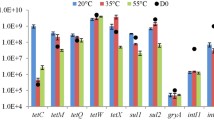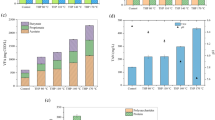Abstract
The role of norfloxacin (NOR) and sulfamethoxazole (SMX) in mesophilic and thermophilic anaerobic digestion (AD) of pig manure, with respect to methane production and variations in the microbial community and resistance genes, including antibiotic resistance genes (ARGs), class I integrase (intIl), and heavy metal resistance genes (MRGs), was investigated. The results indicated that NOR exerted little influence on the microbial community, whereas SMX negatively affected the acetoclastic methanogens. The abundance of two sulfonamide resistance genes (sul1 and sul2), three quinolone resistance genes (qnrS, parC, and aac(6′)-Ib-cr), and intI1 decreased by 2–3 orders of magnitude at the end of thermophilic AD. In contrast, mesophilic AD was generally ineffective in reducing the abundance of resistance genes. According to the results of redundancy analysis, the abundance of ARGs was affected primarily by microbial community dynamics (68.5%), rather than the selective pressure due to antibiotic addition (13.3%). Horizontal gene transfer (HGT) through intI1 contributed to 26.4% of the ARG variation. The archaeal community also influenced the changes in the resistance genes, and ARG reduction was significantly correlated with enhanced methane production. Thermophilic AD presented a higher methane production potential and greater reduction in resistance gene abundance.

Similar content being viewed by others
References
An X L, Chen Q L, Zhu D, Zhu Y G, Gillings M R, Su J Q (2018). Impact of wastewater treatment on the prevalence of integrons and the genetic diversity of integron gene cassettes. Applied and Environmental Microbiology, 84(9): e02766–02717
Chen Q, An X, Li H, Su J, Ma Y, Zhu Y G (2016). Long-term field application of sewage sludge increases the abundance of antibiotic resistance genes in soil. Environment International, 92–93: 1–10
Chen Z Q, Li M, Wen Q X (2017). Comprehensive evaluation of three sets of advanced wastewater treatment trains for treating secondary effluent: Organic micro-pollutants and bio-toxicity. Chemosphere, 189: 426–434
Duan M L, Li H C, Gu J, Tuo X X, Sun W, Qian X, Wang X J (2017). Effects of biochar on reducing the abundance of oxytetracycline, antibiotic resistance genes, and human pathogenic bacteria in soil and lettuce. Environmental Pollution, 224: 787–795
Gaze W H, Zhang L, Abdouslam N A, Hawkey P M, Calvo-Bado L, Royle J, Brown H, Davis S, Kay P, Boxall ABA, Wellington E M H (2011). Impacts of anthropogenic activity on the ecology of Class 1 integrons and integron-associated genes in the environment. ISME Journal, 5(8): 1253–1261
Grabowski A, Tindall B J, Bardin V, Blanchet D, Jeanthon C (2005). Petrimonas sulfuriphila gen. nov., sp. nov., amesophilic fermentative bacterium isolated from a biodegraded oil reservoir. International Journal of Systematic and Evolutionary Microbiology, 55(3): 1113–1121
Hatamoto M, Imachi H, Fukayo S, Ohashi A, Harada H (2007). Syntrophomonaspalmitatica sp. nov., an anaerobic, syntrophic, long-chain fatty-acid-oxidizing bacterium isolated from methanogenic sludge. International Journal of Systematic and Evolutionary Microbiology, 57(9): 2137–2142
Hu J, Xu Q, Li X, Wang D, Zhou Y, Zhao J, Zhang D, Yang Q, Zeng G (2018). Sulfamethazine affects fermentative short-chain fatty acids production from waste activated sludge. Science of the Total Environment, 639: 1471–1479
Jang H M, Lee J, Choi S, Shin J, Kan E, Kim Y M (2018). Response of antibiotic and heavy metal resistance genes to two different temperature sequences in anaerobic digestion of waste activated sludge. Bioresource Technology, 267: 303–310
Kaplan E, Ofek M, Jurkevitch E, Cytryn E (2013). Characterization of fluoroquinolone resistance and qnr diversity in Enterobacteriaceae from municipal biosolids. Frontiers in Microbiology, 4: 144
Larrañaga O, Brown-Jaque M, Quirós P, Gómez-Gómez C, Blanch A, Rodríguez-Rubio L, Muniesa M (2018). Phage particles harboring antibiotic resistance genes in fresh-cut vegetables and agricultural soil. Environment International, 115: 133–141
Li L H, Li Y, Sun Y M, Yuan Z H, Kang X H, Zhang Y, Yang G X (2018a). Effect of bioaugmentation on the microbial community and mono-digestion performance of Pennisetum hybrid. Waste Management (New York, N.Y.), 78: 741–749
Li Y, Sun Y M, Li L H, Yuan Z H (2018b). Acclimation of acid-tolerant methanogenic propionate-utilizing culture and microbial community dissecting. Bioresource Technology, 250: 117–123
Ma Y, Wilson C A, Novak J T, Riffat R, Aynur S, Murthy S, Pruden A (2011). Effect of various sludge digestion conditions on sulfonamide, macrolide, and tetracycline resistance genes and Class 1 integrons. Environmental Science & Technology, 45(18): 7855e7861
Palmer A C, Kishony R (2013). Understanding, predicting and manipulating the genotypic evolution of antibiotic resistance. Nature Reviews. Genetics, 14(4): 243–248
Selvam A, Zhao Z, Wong J W C (2012). Composting of swine manure spiked with sulfadiazine, chlortetracycline and ciprofloxacin. Bioresource Technology, 126: 412–417
Song W, Wang X J, Gu J, Zhang S Q, Yin Y N, Li Y, Qian X, Sun W (2017). Effects of different swine manure to wheat straw ratios on antibiotic resistance genes and the microbial community structure during anaerobic digestion. Bioresource Technology, 231: 1–8
Wang H T, Chi Q Q, Zhu D, Li G, Ding J, An X L, Zheng F, Zhu Y G, Xue X M (2019). Arsenic and sulfamethoxazole increase the incidence of antibiotic resistance genes in the gut of earthworm. Environmental Science & Technology, 53(17): 10445–10453
Wen Q X, Chen Z Q, Wang C Y, Ren N Q (2012). Bulking sludge for PHA production: Energy saving and comparative storage capacity with well-settled sludge. Journal of Environmental Sciences-China, 24(10): 1744–1752
Xiong X, Li Y X, Li W, Lin C Y, Han W, Yang M (2010). Copper content in animal manures and potential risk of soil copper pollution with animal manure use in agriculture. Resources, Conservation and Recycling, 54(11): 985–990
Xu R, Yang Z H, Zheng Y, Liu J B, Xiong W P, Zhang Y R, Lu Y, Xue W J, Fan C Z (2018). Organic loading rate and hydraulic retention time shape distinct ecological networks of anaerobic digestion related microbiome. Bioresource Technology, 262: 184–193
Xu R, Yang Z H, Zheng Y, Wang Q P, Bai Y, Liu J B, Zhang Y R, Xiong W P, Lu Y, Fan C Z (2019). Metagenomic analysis reveals the effects of long-term antibiotic pressure on sludge anaerobic digestion and antimicrobial resistance risk. Bioresource Technology, 282: 179–188
Yang Z M, Shi X S, Dai M, Wang L, Xu X H, Guo R B (2018). Promoting degradation of 2,4-dichlorophenoxyacetic acid with fermentative effluents from hydrogen-producing reactor. Chemosphere, 201: 859–863
Yi J, Dong B, Jin J W, Dai X H (2014). Effect of increasing total solids contents on anaerobic digestion of food waste under mesophilic conditions: Performance and microbial characteristics analysis. PLoS One, 9(7): e102548
Zhang J Y, Sui Q W, Tong J, Buhe C, Wang R, Chen M X, Wei Y S (2016). Sludge bio-drying: Effective to reduce both antibiotic resistance genes and mobile genetic elements. Water Research, 106: 62–70
Zhang J Y, Sui Q W, Zhong H, Meng X S, Wang Z Y, Wang Y W, Wei Y S (2018). Impacts of zero valent iron, natural zeolite and Dnase on the fate of antibiotic resistance genes during thermophilic and mesophilic anaerobic digestion of swine manure. Bioresource Technology, 258: 135–141
Zhang J Y, Wang Z Y, Lu T D, Liu J B, Wang Y W, Shen P H, Wei Y S (2019). Response and mechanisms of the performance and fate of antibiotic resistance genes to nano-magnetite during anaerobic digestion of swine manure. Journal of Hazardous Materials, 366: 192–201
Zhang T, Yang Y, Pruden A (2015). Effect of temperature on removal of antibiotic resistance genes by anaerobic digestion of activated sludge revealed by metagenomic approach. Applied Microbiology and Biotechnology, 99(18): 7771–7779
Zhao L, Ji Y, Sun P Z, Deng J H, Wang H Y, Yang Y K (2019). Effects of individual and combined zinc oxide nanoparticle, norfloxacin, and sulfamethazine contamination on sludge anaerobic digestion. Bioresource Technology, 273: 454–461
Zheng J, Gao R X, Wei Y Y, Chen T, Fan J Q, Zhou Z C, Makimilua T B, Jiao Y N, Chen H (2017). High-throughput profiling and analysis of antibiotic resistance genes in east Tiaoxi River. China. Environmental Pollution, 230: 648–654
Zhou X, Wang J, Lu C, Liao Q, Gudda F O, Ling W (2020). Antibiotics in animal manure and manure-based fertilizers: Occurrence and ecological risk assessment. Chemosphere, 255: 127006
Zwietering M H, Jongenburger I, Rombouts F M, Van’t Riet K (1990). Modeling of the bacterial growth curve. Applied and Environmental Microbiology, 56(6): 1875–1881
Acknowledgements
This work was supported by the National Natural Science Foundation of China (Grant No. 51878214) and the National Key Research and Development Program of China (No. 2019YFD1100200).
Author information
Authors and Affiliations
Corresponding author
Additional information
Highlights
• SMX addition had negative effect on acetoclastic methanogens in mesophilic AD.
• Thermophilic AD was more effective in eliminating resistance genes than mesophilic.
• ARGs variations in AD were mainly affected by succession of microbial community.
• Methane production was significant associated to ARGs reduction.
Electronic supplementary material
Rights and permissions
About this article
Cite this article
Wen, Q., Yang, S. & Chen, Z. Mesophilic and thermophilic anaerobic digestion of swine manure with sulfamethoxazole and norfloxacin: Dynamics of microbial communities and evolution of resistance genes. Front. Environ. Sci. Eng. 15, 94 (2021). https://doi.org/10.1007/s11783-020-1342-x
Received:
Revised:
Accepted:
Published:
DOI: https://doi.org/10.1007/s11783-020-1342-x




